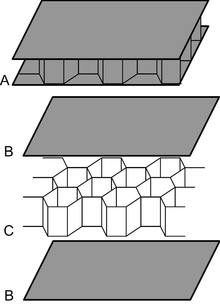Sandwich panel with a honeycomb core
A sandwich panel with a honeycomb core (also known as honeycomb panel for short ) is a three-layer composite structure in a sandwich construction, which consists of two load-bearing outer skins and a honeycomb-shaped support core . The support core is also called english Honeycomb ( German honeycomb ) denotes whose structure bionics taken and are made of cardboard, resin-impregnated paper, nonwoven plastic or thin aluminum foils. The outer skins can be made of cardboard, plastic, fiber composites or sheet metal. Different material combinations between the support core and cover skins are possible; Support core and skins are usually glued.
Functional principle and physical application limits
The sandwich panel adopts the principle of the double T-girder for the planar structure , in that the thin outer skins with their large distance from the central surface ensure a large area moment of inertia and thus high flexural rigidity, while the support core simultaneously generates shear rigidity and the outer skins continuously prevent bumps and wrinkles supports.
The sandwich panel with a foam core as an alternative sandwich panel construction is cheaper to manufacture, but not as resilient. Sandwich panels with a honeycomb core are designed with quasi-isotropic flexural rigidity despite the non-rotationally symmetrical hexagonal shape of the honeycomb and are typically found in lightweight construction . a. in aircraft construction application.
Material of the support core
Paper honeycomb
Honeycomb panels with a support core made of paper or cardboard can be equipped so that they can be loaded with more than 50 tons per m². The outer skins can be made from natural wood, chipboard or MDF . With the same flexural strength , the density is significantly reduced compared to solid chipboard.
The lightweight construction with wood raw materials counteracts a future shortage of wood, reduces transport costs, improves assembly and enables constructions with a higher payload due to lower static loads.
Typical areas of application for honeycomb panels with a paper core are trade fair construction , partition walls, prefabricated house construction , scenery and stage construction, sliding doors , acoustic construction, floor systems, staircase construction , ceiling cladding , wall cladding , caravan construction , shelving , packaging and furniture construction .
Daniel Libeskind received the Hiroshima Art Prize in 2002 for his models, which consist exclusively of cardboard honeycomb panels.
Plastic and fiber composite

Be prepared Honeycombs made of plastics such as polypropylene (PP) or polycarbonate (PC). The technical honeycombs are created by gluing tubes produced in the extrusion process, which are divided into the sheet material.
Since 2010, PP honeycomb cores have also been manufactured in a continuous production process. The process is patented worldwide. It was developed by the Belgian company EconCore NV together with the German ThermHex Waben GmbH.
Aramid fibers are also used , for example Nomex paper and Kevlar paper . These are covered with synthetic resin, for example epoxy or phenolic resin, in order to increase the stability and to prevent the absorption of liquids.
aluminum
Aluminum is also used , especially in aerospace technology. To take advantage of the tensile strength of aluminum skins, an aluminum honeycomb core is required. The largest manufacturers of aluminum honeycomb composite panels are 3A Composites with the product Alucore.
use
The honeycomb structure of the material creates a high mechanical rigidity with a comparatively low weight, which makes the sandwich construction u. a. attractive to the aerospace , marine and aerospace industries . Thus, so-called. Honeycomb panels in aircraft control surfaces and - airfoil , lightweight hulls , surfboards and trucks used superstructures. Simple interior building doors use this type of construction. For some years now, polyurethane fiberglass honeycomb parts have also been used in automobiles as spare wheel covers, hat racks and sliding headliners.
literature
- Hans Peter Degischer, Sigrid Lüftl (Hrsg.): Lightweight construction: principles, material selection and production variants . Wiley-VCH, Weinheim 2009, ISBN 978-3-527-32372-2 .
- Johannes Wiedemann Lightweight Construction: Elements and Construction , 3rd edition. Springer, Berlin 2006, ISBN 978-3-540-33656-3 .
Web links
Individual evidence
- ↑ http://www.wabenplatten.eu/cms/?q=en/node/4
- ↑ ftp://ftp.fh-biberach.de/pub/www/IfH/01_Zukunft_Holz/zh_k09.pdf ( page no longer available , search in web archives ) Info: The link was automatically marked as defective. Please check the link according to the instructions and then remove this notice.
- ↑ Petra Schmidt, Nicola Stattmann: Unfolded: Paper in Design, Art, Architecture and Industry . Birkhäuser, Basel 2009, ISBN 978-3-0346-0031-6 .
- ↑ Archived copy ( memento of the original from March 14, 2011 in the Internet Archive ) Info: The archive link was inserted automatically and has not yet been checked. Please check the original and archive link according to the instructions and then remove this notice.
- ↑ Carbon Composites Magazin, 1/2014, p. 19

